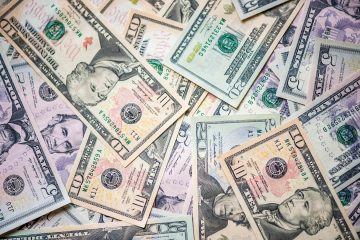Dollar in doldrums as recovery optimism thrives

The U.S. dollar was pinned down on Tuesday, as vaccine optimism boosted the British pound to an almost three-year high, while rising oil prices and buoyant expectations for global recovery supported commodity and trade-exposed currencies.
In trade thinned by Lunar New Year holidays in China and Monday’s U.S. holiday, the positive mood also weighed on the safe-haven yen which made a one-week low on the dollar overnight and fell to more than two-year lows on the euro and the Aussie.
The U.S. dollar index, which measures the dollar against a basket of six major currencies, sat at 90.351, not far above a two-week low it struck last Wednesday.
The Chinese yuan, a favored vehicle for playing the dollar’s weakness in Asia, was on the brink of strengthening past 6.4 per dollar for the first time since mid-2018 and last stood at 6.4033 in offshore trade.
The risk-sensitive Australian dollar held near Monday’s one-month high at $0.7785.
“The dollar tends to underperform when you see this broad positive sentiment in markets,” said Rodrigo Catril, senior currency strategist at National Australia Bank in Sydney.
“There are also inflationary pressures particularly coming from energy prices,” he said, which is pushing up nominal yields — adding another weight on the yen as that can attract flows from Japan — but keeping real returns on Treasuries steady.
Bitcoin hovered just short of $50,000 as profit taking paused the cryptocurrency’s steep rally that has carried it more than 60% higher in 2021 so far.
The yield on benchmark ten-year U.S. Treasuries <US10YT=RR> leapt five basis points to 1.2501% in early Asia trade on Monday, while most major currencies were steady.
Sterling, which broke past $1.39 for the first time in almost three years on Monday, held at $1.3912. It also held steady at 87.15 pence per euro, its highest since May 2020.
Sterling has gained as much as 2.5% on the dollar in less than two weeks as the aggressive rollout of Britain’s COVID-19 vaccination programme has raised expectations its economy will be able to recover more swiftly than European peers’.
The euro was steady at $1.2132 on Tuesday while the yen, which has dropped 2% so far this year, nursed losses at 105.36 per dollar. The yen also hit its lowest since late 2018 against the euro and the Australian dollar and hit a three-year low on the Swiss franc.
“The yen has been the worst performing currency of 2021, with its negative correlation to U.S. Treasury yields proving to be the biggest dampening factor,” said Francesco Pesole, currency strategist at Dutch bank ING in a note to clients.
“When adding weak safe-haven demand as the global recovery gathers pace, some additional trimming of yen net long positions may be on the cards.”
Ahead on Tuesday, investors are looking to eurozone growth estimates, a German sentiment survey and U.S. manufacturing data to gauge the relative pace of the world’s pandemic recovery.




